So, you’ve decided that localization is a good idea to reach more gamers and make more sales. But which game markets should you focus on and what languages should you therefore localize into? And in what order? There are actually quite a few factors that come into play in this decision.
Your question “What will be my ROI for localization into language X?” is actually two questions:
- How much will it cost to localize into language X?
- Will it be successful / sell well among speakers of language X?
How much will it cost to localize?
If you are new to localization, understanding pricing may be hard. If you do a bit of research online or talk to a few vendors, you may find quotes that vary by a large margin. Why is it? Is it simply because some providers are greedier than others? That may be one reason, but let’s look at what actually influences final price. First of all, localization doesn’t mean just one thing. Basically, it involves translation of text, plus “everything else”.
What is “translation”?
So that’s already a bit confusing, but translation doesn’t mean just one thing either! There are free options like Google Translate (not recommended) or fan translation / crowdsourcing (if you have a dedicated fan base). You can also hire independent translators directly or work with an agency. Actually, agencies offer different services under the name “translation” and are not always transparent about what exactly is included in the price. Commonly used processes include:
- Translation only – one translator works on it and it’s done;
- Translation with proofreading – there is a second person checking the work, but they don’t speak the source language;
- Translation with editing – the second person is a translator too and checks the translation against the source;
- Automated quality checks – most agencies use QA software to check for things like double spaces or missing punctuation; may or may not be added to any of the above.
The process chosen influences the price as well as the result, so when looking at offers from different vendors make sure you are comparing apples to apples.
The other big factor is the target language. Here’s a chart showing how rates compare between languages. It is based on Andovar’s pricing, so it may be a bit different for other vendors, but in general the same languages will be expensive and the same ones cheap.
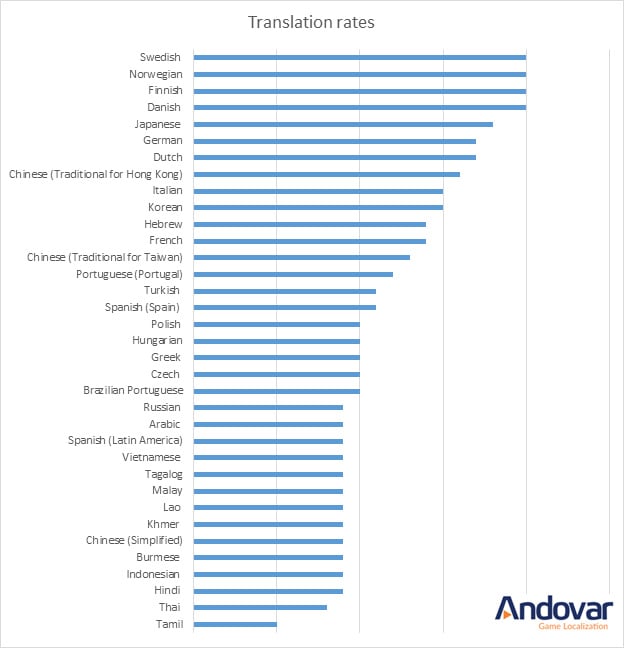
As you can see, it may cost up to four times more to translate into some languages. Why? It’s a free market, so prices depend on supply and demand, and on what individual translators charge. For some languages (or language pairs actually), there are plenty of qualified translators and competition keeps rates low. For others, good professionals with gaming background are scarce, and they charge a premium. Additionally, some languages are only spoken in countries with high costs of living and translators need to charge more to support themselves there.
Now that we know what “translation” means, let’s look at “everything else”.
What is “everything else”?
If all you needed to localize a game was to translate the text, life would be easy and half of the world’s translation agencies would go bankrupt. Things are not that simple though and many other tasks may be involved:
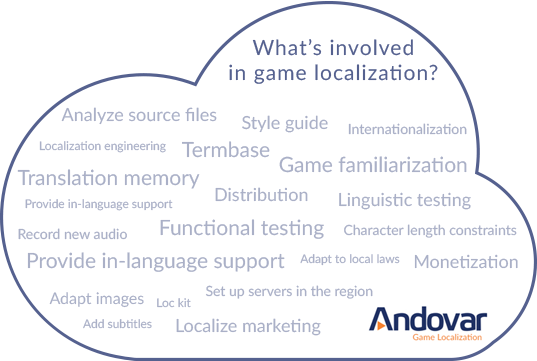
The “everything else” can be quite a lot! Each of these terms deserves a dedicated blog post, but there’s no room for this here. Suffice to say that translation itself is not all that’s needed and not all that contributes to the total cost of localization. If you are not sure which of the above you might need in your next localization project, talk to your localization provider. If they try to convince you that text translation is enough, maybe it’s time to get a second opinion.
Marketing the game locally is likely to cost much more than localization itself. Did you know that:
- Search engines - Google is not the main search engine everywhere. Baidu is the leader in China, Yandex in Russia, and Naver in South Korea.
- Marketing - Different marketing strategies work in each country. For example, TV advertising of games is important in Taiwan.
- App stores - Google Play is only a minor app store in China and Vietnam with local alternatives being much more popular.
- Social media - In many countries Facebook is dominant, but in China it’s Wechat and Sina Weibo and Qzone, In Russia VKontakte and Odnoklassniki, while LINE has a strong position in Japan and Korea.
Will the localized game be successful?
There are different ways to look at success, but for the purpose of this article let’s focus on the financial aspect. If you spend the money to localize a game into a given language, jump through all the hoops mentioned above, will you get a good return on investment? With mobile games, you can test the waters by first translating the description in the app store to judge interest before localizing the game itself, but even that won’t tell you everything.
The short answer is that nobody knows and there is a risk involved regardless of whether you publish the game in the first language or a localized version. But there are ways to mitigate that risk:
- Will the speakers of the new language like the game? If the game has been a success in its primary market, it’s a sign the localized versions may do well. But it’s not that simple. If the new market is very different in terms of culture, gaming habits and price expectations, you need to investigate this deeper. The bigger the differences between markets, the more effort localization will require and the higher the risk of failure. This is especially true of complex, story-driven titles and when bringing games from East to West or West to East.
- How many are there? Speakers of a new language may all live in one country (e.g. Japanese), but they may also be spread across many (e.g. Spanish). In the latter case, should you have one version for all countries or different ones, for example for Spain and Latin America? It costs less to go with one version, but players may feel the product is not really localized for them.
- Do they have money to spend? There are languages with huge numbers of speakers, such as Chinese or Hindi, but the number of potential players who can afford to buy your game or would spend money for in-game purchases is often low. Do the high numbers make up for the lower value per user?
- Do they really need a localized version or will English do? This is a tricky one. The level of English is very high in some countries, especially among gamers. Maybe they don’t even change their operating system to the local language because local translations of “file” and “desktop” sound foreign to them. They wouldn’t buy the localized version because they can’t play the game in English, but they will if the localization is of such high quality that the game is more fun in their mother tongue. At a high level, you can use the English Proficiency Index as a guideline to estimate this:
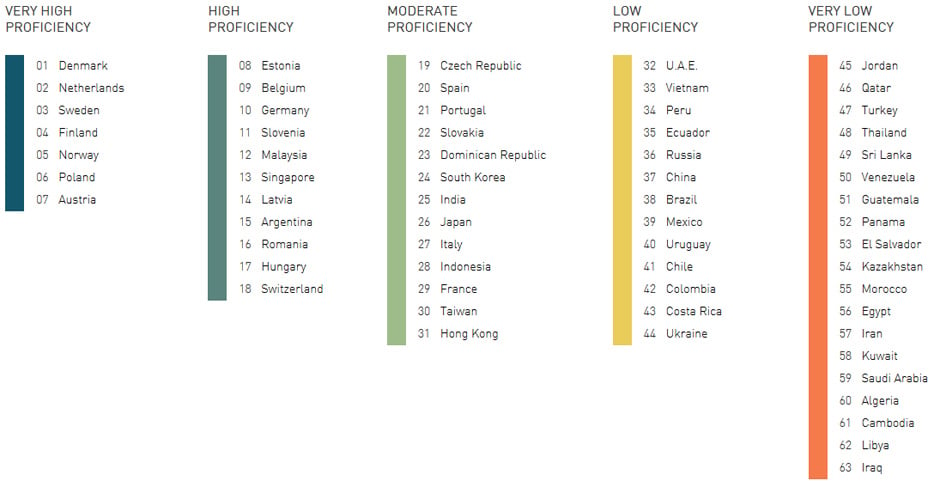
Let’s look at some numbers
As we wrote in a previous article, game localization started with Japanese developers translating their games into English to reach the US market, followed by US companies localizing into FIGS (French, Italian, German and Spanish) for Europe. The second common acronym in localization is CJK, which stands for Chinese, Japanese and Korean and describes the minimum set of Asian languages to localize into. Do these historical notions still hold water when confronted with hard data from recent studies? Let’s look at some charts from the game industry market research company Newzoo.
These are the top 20 markets worldwide in terms of gaming revenue in 2014 (link):
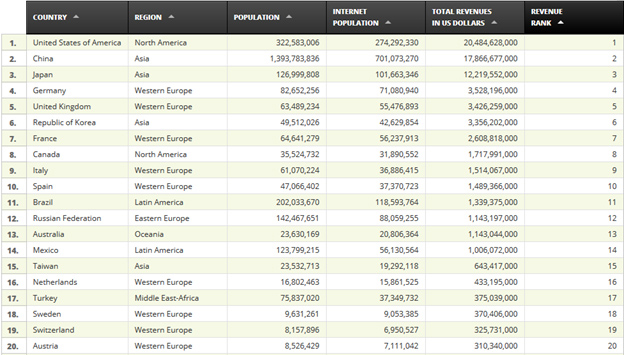
The countries with highest numbers of mobile game spenders in 2014:

The value of games market in each region of the world and their growth dynamics in April, 2015 (link):
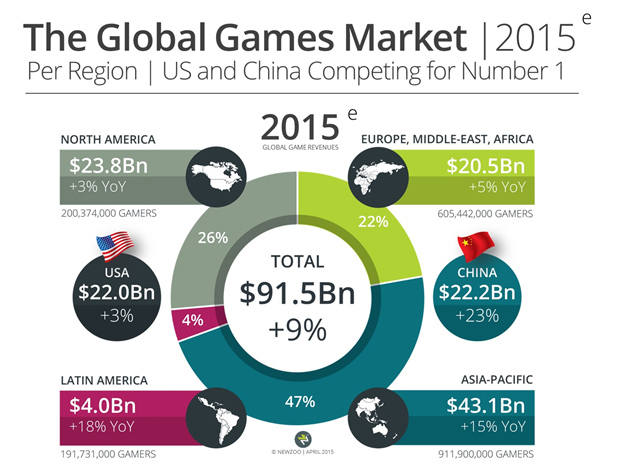
Looking at this data, it appears that the traditional sets of EFIGS and CJK will cover the most important markets, but there are also new and upcoming languages you should take into consideration. There are plenty of statistics, but no one model best practice. Let’s look at the most important languages and their challenges briefly.
EFIGS
English will be either the language your game was developed in, or the first language you should localize into. It gives access not only to the USA – still the world’s largest (soon to be overtaken by China) gaming market, and other English-speaking countries, but also to a large chunk of the rest of the Western world. Players may prefer a local language version, but if the game is good, they’ll play it in English too. The same can’t be said about even the best game available only in Korean or Chinese since these languages have few speakers outside their home countries. You may consider separate localization for UK and US English, especially if the game involves audio. Since English gives you access to players in all geographies, don’t forget about distribution and localization of servers and support.
French localization gives you access not only to France, but to an extent also to Belgium, Switzerland, the French-speaking population of Canada and France’s former colonies. The French are well-known for preferring their own language and it’d be difficult to win them over without high quality localization. France also has a thriving game developer industry, so local competition is a factor.
Italian has always been part of the FIGS acronym and remains an important language, but due to economic woes of Italy in recent years, its position has slipped. It is not spoken by a significant number of people outside its mother country, so a comeback of Italy’s economy will be closely tied to a return to prominence of the language. Whether you consider Italy a priority in your publishing plans, you should keep in mind that the country is used to high-quality localizations from the world’s biggest publishers and won’t settle for less.
German is a safe bet with Germany at number #4 and Austria at #20. From a linguistic point of view, German is closer to English than any of the other FIGS languages (French, Italian or Spanish) and German players tend to speak English better (just look at the English Proficiency Index above!). Whether you decide to have a localized German version depends on your priorities.
Spanish is a special case among the FIGS languages. Originally, Spanish localization was meant for Spain only, but nowadays you should not forget the rising Latin American market with its population of hundreds of millions. This makes Spanish the second or third most spoken language in the world depending on methodology. Although the value of the Latin American market remains very low compared with Europe, it is growing faster than any other region.
CJK
Chinese or more specifically Mandarin Chinese written in Simplified script (official in Mainland China) is the world’s most commonly spoken language and China is not only poised to overtake USA as the world’s largest gaming market this year, but also destined to grow at an astounding pace for years to come. The country lifted its 14-year-long ban on consoles in 2014 and has an appetite for internet, mobiles and electronic entertainment unmatched anywhere else. The bad news is that it remains one of the most difficult markets to enter for outsiders due to cultural differences, local laws and regulations and a strong local industry which knows exactly what Chinese players want. All this makes Mainland China a high-risk and high-investment but possibly high-return proposition for localization.
Japanese must be held in a special place in all game enthusiasts’ hearts. Along with the USA, Japan was the birthplace of the modern gaming industry, the origin of such giants as Nintendo, SEGA and Sony, and beloved brands like Pacman, Sonic and Mario. It is now in third place worldwide after USA and China, and is well-known for dedicated lifelong gaming fans who don’t hesitate to spend on games they love. Despite abundant exchange between Japanese and Western games since the 1980s it remains part of the “mysterious Orient” when it comes to foreign products. The blueprint of what makes a successful localization from the West to Japan or from Japan to the West has not been found yet and many of the world’s biggest companies have failed. Approach with caution.
Korean is last of the Big 3 languages for Asian localization. Despite a relatively small population of under 50 million, South Korea occupies a solid 6th spot in Newzoo’s ranking and has a gaming culture to rival Japan. While it started off importing hardware and software from Japan and the USA, games like MapleStory and Ragnarok established the South Korean video game industry over a decade ago. Nowadays, it is ultra-competitive and a Western title usually requires deep adaptation, a thought-out strategy, and ideally a local partner to be successful. The country is well known as a major hub for eSports with live events attracting millions of viewers.
Others
There are many other languages and markets around the world that may merit localization depending on your strategy, but I would like to look at a few regions that seem especially interesting. While they may not be the first ones to spring to mind, their expected growth promises worthwhile opportunities in the near future.
Russia occupies a niche that’s different from established European and Asian markets. Russia ranks number #12 in terms of global game revenues, but boasts the highest percentage of PC gamers globally, with over 90% playing games on the PC screen. Russia’s mobile gaming market is relatively new, which gives opportunistic developers a high probability of success. Anyone entering the Russian market will face competition from well-established local companies, some virtually unknown outside of the country. Bear in mind that Russian economy tends to be volatile and due to high retail prices and poor copyright enforcement, piracy is a serious problem.
India is a close second behind China in population. While it remains underdeveloped and with relatively low internet penetration and a nascent gaming culture, it is on the path to growth in all areas and we expect it will become a force to be reckoned with due to its sheer size. The challenge of course is – what language do they speak in India? There are 22 official languages in the country, but many players actually use English although it is only spoken by an estimated small percentage of the population. With an annual spend of over $90 million, India is an emerging market with a lot of untapped potential, but the per-capita GDP is so low, that mobile games can be purchased for as little as 0.02 USD.
Brazil’s digital game market reached $1.4 billion in 2014. While the whole region of Latin America is still very small compared to all others, it is also the fastest growing. This puts Brazilian Portuguese in the same basket as Latin American Spanish as two major emerging languages for the gaming industry. However, while Spanish used in Spain and in Latin American countries are not that different, the Portuguese used in Brazil requires a dedicated localized version.
Southeast Asia is one of the fastest growing markets, especially in mobile gaming. There are fewer local players and less competition than in China, Japan or South Korea. On the other hand, SEA is very diverse both linguistically and culturally and each country requires individual attention. Although it contains 11 countries, only six of them account for 99% of the region’s gaming revenues: Indonesia, Malaysia, the Philippines, Singapore, Thailand and Vietnam.
Wrapping up
In summary, the mainstream European languages are a safe bet. French, German, Spanish, Portuguese, Italian are the traditional languages to start with. In Asia, China, Japan and Korea are the massive markets, but you need to do more than just translate. Latin America, Southeast Asia, Russia and India are growing fast, but the market sizes and average revenue per user are much smaller. When deciding on languages, remember to take not only the translation cost, but also all collateral expenses into consideration.
More resources:
For more information on game markets, visit our overview on the games localization industry and visit or get added insights from our Ultimate Guide on Games Translation.












